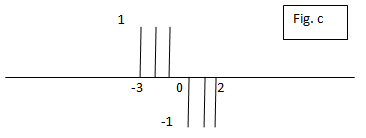This set of Signals & Systems Multiple Choice Questions & Answers (MCQs) focuses on “Classification of Signals”.
1. What is single-valued function?
a) Single value for all instants of time
b) Unique value for every instant of time
c) A single pattern is followed by after ‘t’ intervals
d) Different pattern of values is followed by after ‘t’ intervals of time
View Answer
Explanation: Single-valued function means “for every instant of time there exists unique value of the function”.
2. In real valued function and complex valued function, time is _______________
a) Real
b) Complex
c) Imaginary
d) Not predictable
View Answer
Explanation: Time is an independent variable and it is real valued irrespective of real valued or complex valued function. And time is always real.
3. Discrete time signal is derived from continuous time signal by _____________ process.
a) Addition
b) Multiplying
c) Sampling
d) Addition and multiplication
View Answer
Explanation: Sampling is a process wherein continuous time signal is converted to its equivalent discrete time signal. It is given by t = N*t.
4. Even signals are symmetric about the vertical axis.
a) True
b) False
View Answer
Explanation: Signals are classified as even if it has symmetry about its vertical axis. It is given by the equation x (-t) = x (t).
5. If x (-t) = -x (t) then the signal is said to be _____________
a) Even signal
b) Odd signal
c) Periodic signal
d) Non periodic signal
View Answer
Explanation: Signals is said to be odd if it is anti- symmetry over the time origin. And it is given by the equation x (-t) = -x (t).
6. Which of the following is true for complex-valued function?
a) X (-t) = x*(t)
b) X (-t) = x(t)
c) X (-t) = – x(t)
d) X (-t) = x*(-t)
View Answer
Explanation: Complex-valued function is said to be conjugate symmetry if its real part is even and imaginary part is odd and it is shown by the equation x(-t) = x*(t).
7. When x(t ) is said to be non periodic signal?
a) If the equation x (t) = x (t + T) is satisfied for all values of T
b) If the equation x (t) = x (t + T) is satisfied for only one value of T
c) If the equation x (t) = x (t + T) is satisfied for no values of T
d) If the equation x (t) = x (t + T) is satisfied for only odd values of T
View Answer
Explanation: A signal x (t) is said to be non periodic signal if it does not satisfy the equation x(t) = x(t + T). And it is periodic if it satisfies the equation for all values of T = T0, 2T0, 3T0…
8. Fundamental frequency x[n] is given by ___________
a) Omega = 2*pi /N
b) Omega = 2*pi*N
c) Omega = 4*pi *2N
d) Omega = pi / N
View Answer
Explanation: Fundamental frequency is the smallest value of N which satisfies the equation
Omega = 2*pi/ N, Where N is a positive integer.
9. Noise generated by an amplifier of radio is an example for?
a) Discrete signal
b) Deterministic signal
c) Random signal
d) Periodic signal
View Answer
Explanation: Random signal is the one which there is uncertainty before its actual occurrence. Noise is a best example for random signal.
10. Energy signal has zero average power and power signal has zero energy.
a) True
b) False
View Answer
Explanation: Energy and power signals are mutually exclusive. Energy signal has zero average power and power signal has infinite energy.
11. What is the fundamental frequency of discrete –time wave shown in fig a?
a) π/6
b) π/3
c) 2π/8
d) π
View Answer
Explanation: Omega = 2* π / N. In the given example the number of samples in one period is N = 6. By substituting the value of N =6 in the above equation then we get fundamental frequency as π/3.
12. Calculate the average power of the discrete-time wave shown in fig a?
a) 1
b) 6
c) 0
d) -1
View Answer
Explanation: The given formula is
 used to calculate average power for Periodic -discrete signal. By substituting the value of N and x2[n] in the given then we get the required answer.
used to calculate average power for Periodic -discrete signal. By substituting the value of N and x2[n] in the given then we get the required answer.13. What is the total energy of rectangular pulse shown in fig b?
a) 8A2
b) 4A
c) 2A
d) 4A2
View Answer
Explanation:
 The total energy of the rectangular pulse can be found by integrating the square of the signal. Basically energy is given by area under the curve.
The total energy of the rectangular pulse can be found by integrating the square of the signal. Basically energy is given by area under the curve.14. What is the total power of the rectangular pulse shown in fig b?
a) 0
b) 8A2
c) ∞
d) 2A
View Answer
Explanation: Energy signals have zero power and finite energy. Figure b is an example of an energy signal. This is one of the definition/ properties of the energy signal.
15. What is the total energy of the signal shown in fig c?

a) 6
b) 0
c) 3
d) 1
View Answer
Explanation: The given figure is an example of an energy signal hence the energy of a discrete-time signal is given by the equation E = ∑ x2[n].
Sanfoundry Global Education & Learning Series – Signals & Systems.
To practice all areas of Signals & Systems, here is complete set of 1000+ Multiple Choice Questions and Answers.
If you find a mistake in question / option / answer, kindly take a screenshot and email to [email protected]


